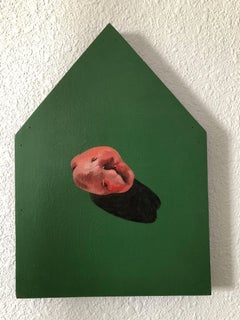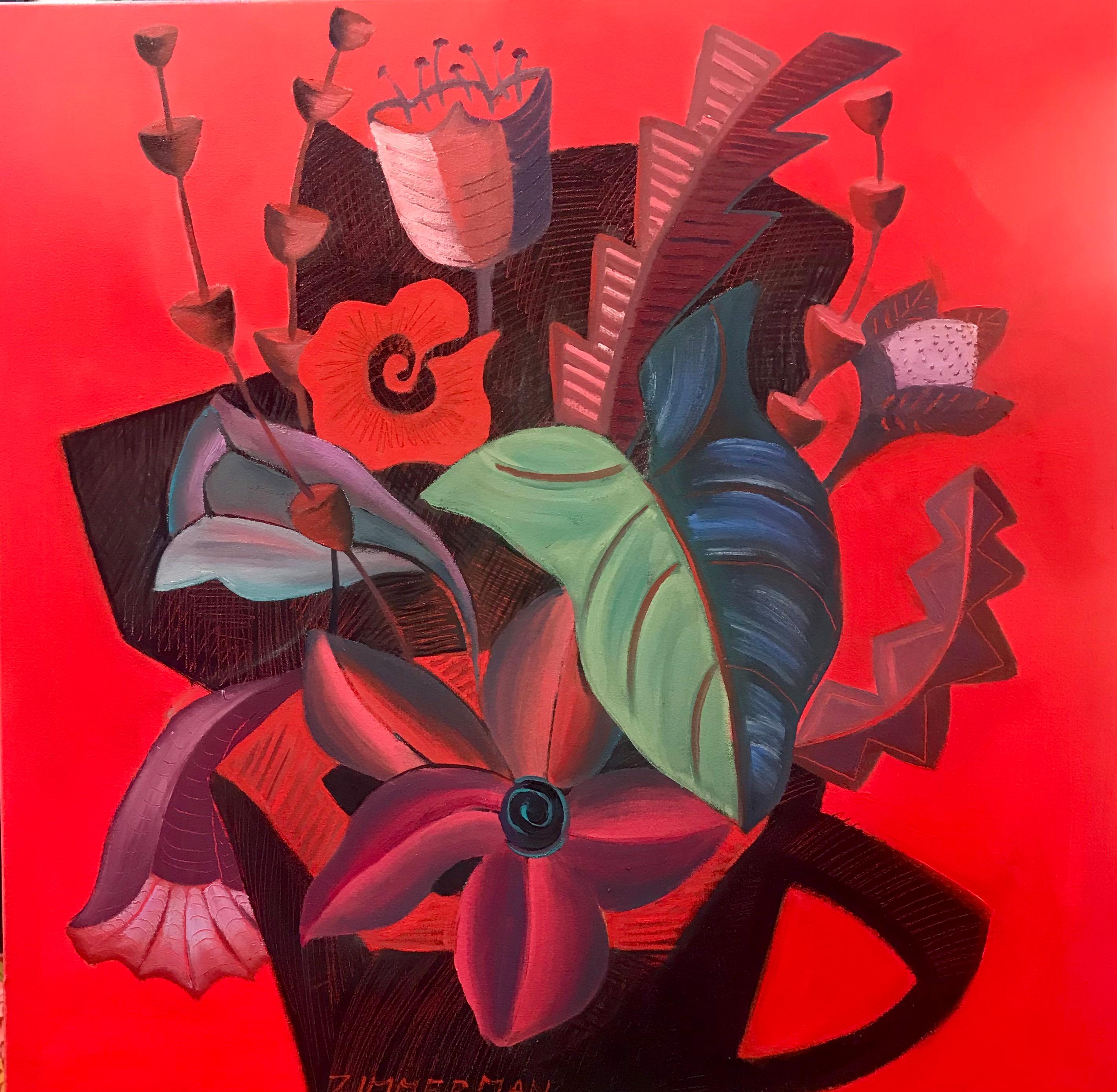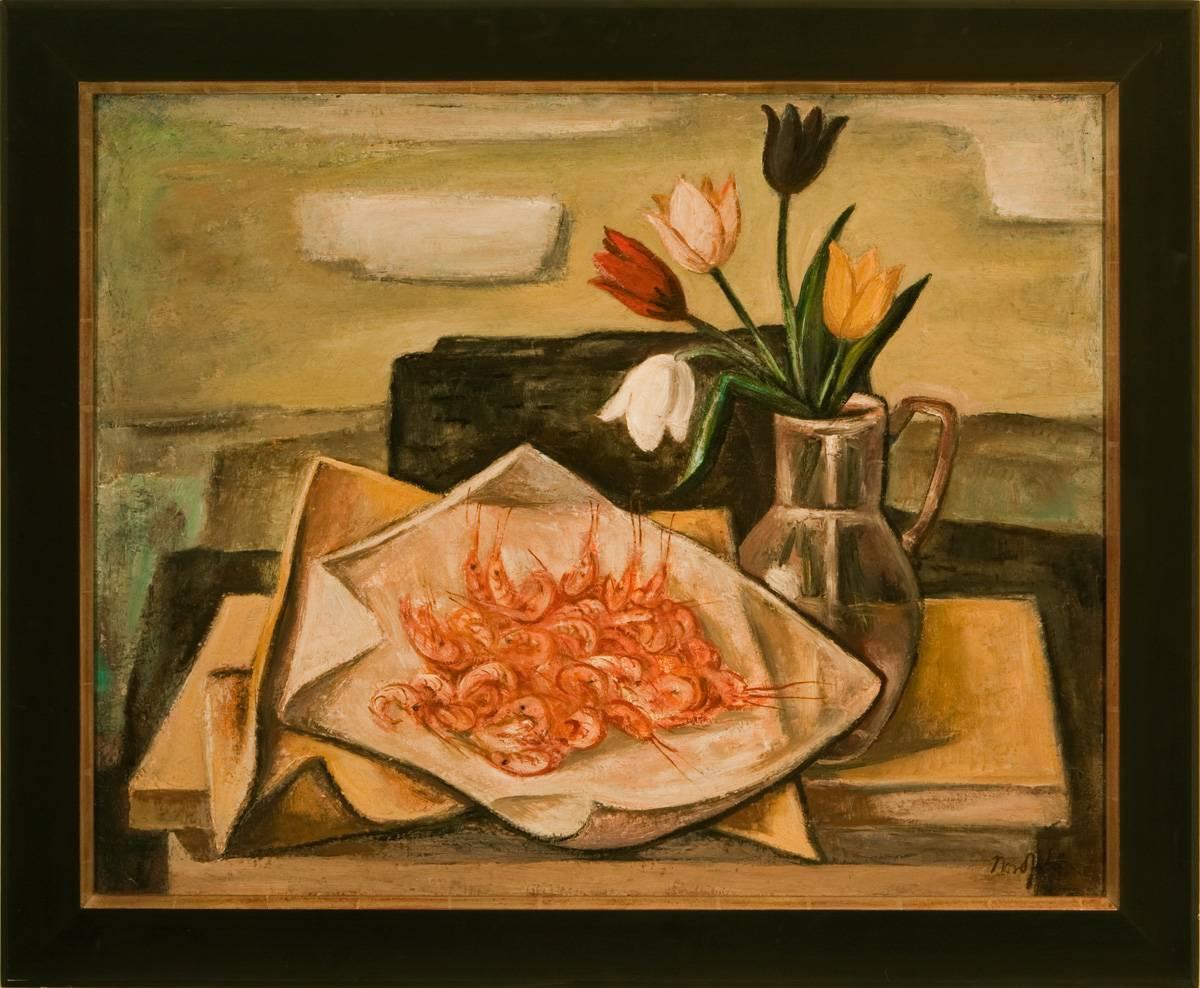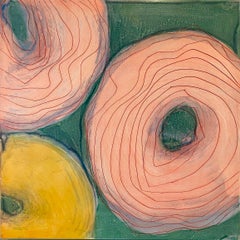
Shaped Canvas Oil Painting, Potato on Green Triangle
View Similar Items
Want more images or videos?
Request additional images or videos from the seller
1 of 12
Sven LukinShaped Canvas Oil Painting, Potato on Green Triangle1996
1996
About the Item
- Creator:Sven Lukin (1934, American)
- Creation Year:1996
- Dimensions:Height: 18.5 in (46.99 cm)Width: 13 in (33.02 cm)
- Medium:
- Movement & Style:
- Period:
- Condition:minor wear.
- Gallery Location:Surfside, FL
- Reference Number:1stDibs: LU3822524911
About the Seller
4.9
Platinum Seller
These expertly vetted sellers are 1stDibs' most experienced sellers and are rated highest by our customers.
Established in 1995
1stDibs seller since 2014
1,541 sales on 1stDibs
Typical response time: 1 hour
More From This SellerView All
- Large Trompe L'oeil Hyperrealism Painting Abstract Surrealist Photo Realist ArtLocated in Surfside, FLLarge acrylic painting by Pat Rosenstein, American Woman Artist, graduate of Pratt Institute whose work has been exhibited extensively. Rosenstein, who...Category
1990s American Modern Still-life Paintings
MaterialsCanvas, Acrylic
- Abstract Flowers Oil Painting Study for AmaryllisBy Nobu FukuiLocated in Surfside, FLThis piece is done in a sort of sgraffito technique with the flowers sort of etched in the paint. Born in Tokyo, Japan, Nobu Fukui Came to New York where he became a US citizen. From 1964 - 65, he studied at the Art Students League in New York City. His work has been widely exhibited in New York and California. He had his first one-man show in this country in 1965 at the Daniels Gallery in New York. That same year his works were included in the Japanese Artists in Europe and America Exhibition at the National Museum of Modern Art in Tokyo. This was followed by numerous exhibits and one-man shows in various cities in the United States and Japan - New York, Indianapolis, Ann Arbor, Pittsburgh and Yokohama, for example. Fukui's works are formal, dynamic and abstract. Form functions minimally as a symmetrical structure so as to focus on his real interest in color interaction. Fukui's work is represented in the collections of The Museum of Modern Art, New York City; Larry Aldrich Museum, Conn; Dartmouth College, NH; New York State University, Potsdam NY; Roosevelt College, Chicago IL; Westinghouse Corp, The National Museum of Modern Art, Tokyo, Japan; The New Britain Museum of American Art, New Britain, CT; The Indianapolis Museum of Art, Indianapolis, IN and The Eli and Edythe Broad Art Museum, East Lansing, MI, Indianapolis Museum of Art; National Museum of Modern Art, Tokyo and National Museum of Modern Art, Kyoto, Japan; amongst others. and other private collections. He has exhibited widely, including solo shows at Daniels Gallery, Max Hutchinson Gallery, Marisa Del Re Gallery, and Steven Haller...Category
1990s Abstract Abstract Paintings
MaterialsCanvas, Oil, Panel
- "AKEE" Oil Painting, Marylyn Dintenfass Modernist Abstract Expressionist Pop ArtBy Marylyn DintenfassLocated in Surfside, FLProvenance: Babcock Galleries (bears their label verso.) signed verso with artists monogram signature. Marylyn Dintenfass (born 1943) is an American painter, printmaker, and sculptor. She is primarily known for her oil paintings, which use a dynamic color palette and lexicon of gestural imagery to explore dualities in the human experience and everyday sensual pleasures. Marylyn Dintenfass was born in 1943 in Brooklyn, New York and spent most of her early years in Brooklyn and then Long Island. She attended Queens College, and graduated in 1965 with a bachelor's degree in Fine Arts. During this time, the artist worked with Abstract Expressionist painter John Ferren and muralist Barse Miller. Marilyn Dintenfass explored new media and developed her own reaction to abstract expressionism with color, line, and gesture. Dintenfass acquired an appreciation for a broad range of materials that led to major sculpture installations composed of ceramic materials, steel, lead, wood, wax and a variety of pigments and epoxies. Following a tour of museums in Amsterdam, Paris and Rome, the artist made her way to Jerusalem in 1966. During this journey, the artist worked with painter Ruth Bamberger, studied etching and mingled with the artists and intellectuals of the city. The result was Dintenfass's first architectural commission, to design the “Pop Op Disco,” Jerusalem's first disco. This commission allowed her to work with an array of materials to employ shapes, surfaces, textures, colors, and lights, all of which coalesced in her consciousness that would become important components of her mature personal visual vocabulary. Dintenfass also married and started her family during these years. Art critic Meredith Mendelsohn writes, “Dintenfass uses luscious colors, repetitive forms, and a gestural intensity that combines Abstract Expressionism and Pop Art.” Dintenfass often works with oil paint on wooden panels fragmented into parts of a grid. "After completing a painting," writes curator and critic Lilly Wei in a study of Dintenfass' work, "Dintenfass literally takes it apart, treating each panel as a discrete entity, exchanging panels between works in an aesthetic mix and match as she searches for interactions and relationships of color and form that satisfy her sense of visual excitement, sparked by the frisson of the dissonant." In an interview with critic Irving Sandler, Dintenfass speaks of the grid as a necessary, formal restraint for the passion of the gestural marks it contains. Joyce Robinson illuminates; “Dintenfass is at heart, though, a painter, and the grid, with its reference to and notion of modular parts, has remained central to her artistic enterprise, functioning as a kind of Apollonian matrix holding in check the exuberant, vividly colored abstractions of this essentially Dionysian artist.” Lilly Wei adds, "Ultimately, however, Dintenfass is more sensualist than theorist, and her paintings owe much of their allure to their materiality and the dazzle of color. Her array of ripe, radiant, saturated hues—a palette of gorgeous diversity—can be silkily smooth and nuanced; boldly exuberant; or edgily, feverishly discordant." The artist's abstract imagery usually appears in her work as various forms of stripes or circles arranged across translucent layers of alternating matte and high gloss textures. In a conversation with gallery owner, John Driscoll, Dintenfass likens these symbols to language that predates the written word, saying her "work relates to communication through the visceral channel." Rooted in autobiography, the artist's paintings also examine the contrast between what she calls the “micro” and the “macro.” At times the shapes simultaneously resemble cells under a microscope and visions of the cosmos. Dintenfass' themes explore the dualities of everyday pleasures; depending on the focus of a series, her symbols might conjure characters, candies, car wheels, or paint itself. Although known for her paintings, Dintenfass was first recognized for her sculptural installations. Her innovative use of mixed media (ceramics, epoxies, wax, pigments, steel, lead, wood, etc.) transformed understanding of what a “ceramic” work of art could be and firmly fixed her position and influence among a generation of mixed media artists expanding the traditional definitions and boundaries of object and materials to create modern art. The results came as architectural reliefs and installation sculpture unique to her organic but structural personal style. Similar to her paintings, Dintenfass developed a modular language of symbols, amalgams of line and curve, which she would combine to create detailed pictographic languages all her own, what she has called “organic alphabets.” As Ted Castle relates, “Ideas are furtive elements, stolen from the matrix, so as to be reformed by human genius into something unforeseen—a poem, a painting, a game of dominoes, a television set, a brick, a tile, a cup. Marylyn Dintenfass is a master of the transformation of ideas into palpable form.” Dintenfass has also been commissioned to create many large-scale installations, including works for the State of Connecticut Superior Courthouse; the Port Authority of NY 42nd Street Bus Terminal; IBM in Atlanta, Charlotte, and San Jose; The Baltimore Federal...Category
Early 2000s Abstract Abstract Paintings
MaterialsOil, Panel
- Abstract Red Persimmon Oil Painting on Panel Marylyn Dintenfass ModernistBy Marylyn DintenfassLocated in Surfside, FLProvenance: Babcock Galleries (bears their label verso. signed verso with artists monogram signature. Marylyn Dintenfass (born 1943) is an American painter, printmaker, and sculptor. She is primarily known for her oil paintings, which use a dynamic color palette and lexicon of gestural imagery to explore dualities in the human experience and everyday sensual pleasures. Marylyn Dintenfass was born in 1943 in Brooklyn, New York and spent most of her early years in Brooklyn and then Long Island. She attended Queens College, and graduated in 1965 with a bachelor's degree in Fine Arts. During this time, the artist worked with Abstract Expressionist painter John Ferren and muralist Barse Miller. Marilyn Dintenfass explored new media and developed her own reaction to abstract expressionism with color, line, and gesture. Dintenfass acquired an appreciation for a broad range of materials that led to major sculpture installations composed of ceramic materials, steel, lead, wood, wax and a variety of pigments and epoxies. Following a tour of museums in Amsterdam, Paris and Rome, the artist made her way to Jerusalem in 1966. During this journey, the artist worked with painter Ruth Bamberger, studied etching and mingled with the artists and intellectuals of the city. The result was Dintenfass's first architectural commission, to design the “Pop Op Disco,” Jerusalem's first disco. This commission allowed her to work with an array of materials to employ shapes, surfaces, textures, colors, and lights, all of which coalesced in her consciousness that would become important components of her mature personal visual vocabulary. Dintenfass also married and started her family during these years. Art critic Meredith Mendelsohn writes, “Dintenfass uses luscious colors, repetitive forms, and a gestural intensity that combines Abstract Expressionism and Pop Art.” Dintenfass often works with oil paint on wooden panels fragmented into parts of a grid. "After completing a painting," writes curator and critic Lilly Wei in a study of Dintenfass' work, "Dintenfass literally takes it apart, treating each panel as a discrete entity, exchanging panels between works in an aesthetic mix and match as she searches for interactions and relationships of color and form that satisfy her sense of visual excitement, sparked by the frisson of the dissonant." In an interview with critic Irving Sandler, Dintenfass speaks of the grid as a necessary, formal restraint for the passion of the gestural marks it contains. Joyce Robinson illuminates; “Dintenfass is at heart, though, a painter, and the grid, with its reference to and notion of modular parts, has remained central to her artistic enterprise, functioning as a kind of Apollonian matrix holding in check the exuberant, vividly colored abstractions of this essentially Dionysian artist.” Lilly Wei adds, "Ultimately, however, Dintenfass is more sensualist than theorist, and her paintings owe much of their allure to their materiality and the dazzle of color. Her array of ripe, radiant, saturated hues—a palette of gorgeous diversity—can be silkily smooth and nuanced; boldly exuberant; or edgily, feverishly discordant." The artist's abstract imagery usually appears in her work as various forms of stripes or circles arranged across translucent layers of alternating matte and high gloss textures. In a conversation with gallery owner, John Driscoll, Dintenfass likens these symbols to language that predates the written word, saying her "work relates to communication through the visceral channel." Rooted in autobiography, the artist's paintings also examine the contrast between what she calls the “micro” and the “macro.” At times the shapes simultaneously resemble cells under a microscope and visions of the cosmos. Dintenfass' themes explore the dualities of everyday pleasures; depending on the focus of a series, her symbols might conjure characters, candies, car wheels, or paint itself. Although known for her paintings, Dintenfass was first recognized for her sculptural installations. Her innovative use of mixed media (ceramics, epoxies, wax, pigments, steel, lead, wood, etc.) transformed understanding of what a “ceramic” work of art could be and firmly fixed her position and influence among a generation of mixed media artists expanding the traditional definitions and boundaries of object and materials to create modern art. The results came as architectural reliefs and installation sculpture unique to her organic but structural personal style. Similar to her paintings, Dintenfass developed a modular language of symbols, amalgams of line and curve, which she would combine to create detailed pictographic languages all her own, what she has called “organic alphabets.” As Ted Castle relates, “Ideas are furtive elements, stolen from the matrix, so as to be reformed by human genius into something unforeseen—a poem, a painting, a game of dominoes, a television set, a brick, a tile, a cup. Marylyn Dintenfass is a master of the transformation of ideas into palpable form.” Dintenfass has also been commissioned to create many large-scale installations, including works for the State of Connecticut Superior Courthouse; the Port Authority of NY 42nd Street Bus Terminal; IBM in Atlanta, Charlotte, and San Jose; The Baltimore Federal...Category
Early 2000s Abstract Abstract Paintings
MaterialsOil, Panel
- Bold Color French Modernist Painting 1958 Signed Aldo Abstract Still LifeLocated in Surfside, FLMid century modern art with inscription in french verso. It was traded with another artist.Category
1950s Modern Abstract Paintings
MaterialsPaper, Oil, Gouache
- 1970s Large Wood, Copper Inlay Sculpture Wall Relief Tropical Flowers MotifBy Helen WeberLocated in Surfside, FLHelen Weber Large wall hanging wood and metal sculptural relief in a tropical Hawaiian or Polynesian motif with tropical flowers. "Art belongs everywhere from cruise ships to church...Category
1970s American Modern Still-life Sculptures
MaterialsCopper
You May Also Like
- Black Cherries - Vibrant Red Fruit Southwest Inspired Pop Art Food PaintingBy Will BegerLocated in Los Angeles, CAWill Beger and his contemporary-minimalist paintings, take on an entirely unique approach to southwest art. Influenced by his youth and inspired by nature, he effortlessly captures a...Category
21st Century and Contemporary American Modern Still-life Paintings
MaterialsResin, Mixed Media, Acrylic, Wood Panel
- Velloso - Vibrant Orange Green Southwest Inspired Pop Art Cactus PaintingBy Will BegerLocated in Los Angeles, CAWill Beger and his contemporary-minimalist paintings, take on an entirely unique approach to southwest art. Influenced by his youth and inspired by nature, ...Category
21st Century and Contemporary American Modern Still-life Paintings
MaterialsResin, Mixed Media, Acrylic, Wood Panel
- Orange Ostrich - Vibrant Southwest Inspired Pop Art Fruit Bird PaintingBy Will BegerLocated in Los Angeles, CAWill Beger and his contemporary-minimalist paintings, take on an entirely unique approach to southwest art. Influenced by his youth and inspired by nature, he effortlessly captures a...Category
21st Century and Contemporary American Modern Still-life Paintings
MaterialsResin, Mixed Media, Acrylic, Wood Panel
- Hermosa Fresa - Vibrant Red Black Southwest Inspired Pop Art Food PaintingBy Will BegerLocated in Los Angeles, CAWill Beger and his contemporary-minimalist paintings, take on an entirely unique approach to southwest art. Influenced by his youth and inspired by nature, he effortlessly captures a...Category
21st Century and Contemporary American Modern Still-life Paintings
MaterialsResin, Mixed Media, Acrylic, Wood Panel
- Red Floral - Oil Paint By Marc ZimmermanBy Marc ZimmermanLocated in Carmel, CARight as red, this painting is delicious with color. And that accent of the blue/green leaf is just the perfect accent. Red Floral - Oil Paint By Marc Zimmerman This masterpiece is...Category
2010s American Modern Abstract Paintings
MaterialsCanvas, Oil
- Double Sided Painting (Still Life and Abstract) by William Littlefield 1950-1954Located in Long Island City, NYArtist: William Littlefield, American (1902 - 1969) Title: Still Life and Abstract Year: 1950 & 1954 Medium: Double-Sided Oil on Masonite, signed and dated both sides Size: 22 x 28 i...Category
1950s American Modern Still-life Paintings
MaterialsMasonite, Oil







